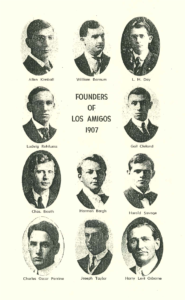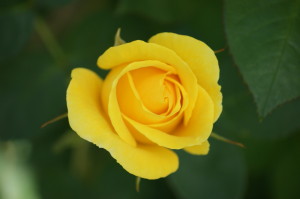
Alpha Kappa Lambda was founded on April 22, 1914, by a group of young men attending the University of California, Berkeley. The significance of this location is Alpha Kappa Lambda is the first fraternity to be founded on the west coast and work east, where most other fraternities at the time, were founded on the east coast and worked west. Its birth, however, dates to 1906 when a group of friends discussed the “need of Christian men for a place to live and study that was within their (financial) means.”
After assisting in the cleanup of the Great 1906 San Francisco Earthquake, four students re-addressed their desire to organize a house club during a YMCA conference in Pacific Grove, California. It was decided to form “Los Amigos” in 1907, which was a house club named from the Spanish translation of “The Friends.” Shortly after, seven more men joined Los Amigos. Reverend Gail Cleland, one of the original 11 members of Los Amigos, recalled, “When we organized Los Amigos as a house club…house clubs and fraternities were dime a dozen. They came, they lived for a few months or a few years, then they went out of existence again. But Los Amigos did not go out of existence.”
He continues, “And seven years later…in response to the suggestion of Benjamin Ide Wheeler, president of the University of California, we organized our house club as a national fraternity of one chapter.” The founders of Los Amigos were a diverse group, but they shared a common desire for studious living in a college environment and continued integrity after their formal education concluded. The profiles of the eleven founding members of Los Amigos are given in the order in which their names appeared on the signatory page of the constitution of Los Amigos. They were “typical” college men in many ways, yet atypical in their desire to foster brotherhood, scholarship, and service through their club.
- Herman Ritchie “Dickie” Bergh was described as a “very likable chap of the happy-go-lucky type. Often broke of money, he was never broke in friends.” Bergh was a student of the College of Social Sciences. After his graduation in 1912, he had the desire to become a foreign missionary. He worked as a company representative in South America briefly before going into real estate in Los Angeles.
- Harold Alonzo “Hal” Savage was a politician of the Los Amigos Club and a student of law. He helped to bring Los Amigos early recognition by being elected President of his sophomore class. He graduated in 1910, and he later became a leading attorney, specializing in mining law.

- Allen Holmes Kimball was an architectural student, who used his artistic abilities to decorate and furnish the club’s modest house comfortably. After graduation in 1910, Kimball designed a new Alpha Chapter house. For many years he was a Professor of Architecture at Iowa State University in Ames, Iowa, and went on to become one of America’s prominent architects.
- Charles Oscar “Oscar” Perrine was in Los Amigos only a short time. He graduated in 1910 but returned later to help with the expansion of the new Fraternity after its founding. Gail Cleland described him as a “tall, strong, silent man who proved remarkably wise and well balanced.” He became involved in several ranching ventures, but later made a name for himself as a commercial photographer.
- Ludwig Rehfuess was registered in the College of Mechanics and was a man described by one of Alpha Kappa Lambda’s charter members, Frank Bloomer (Alpha, California 08), as “always full of life and energy. Some of us thought his opinions rather radical on certain questions, but withal, Ludwig was a wonderful soul, absolutely genuine.” Rehfuess met an untimely death by drowning in Yosemite Valley in June 1911, only a year after receiving his degree. Rehfuess’ name appears as the first entry of our Omega Chapter.
- Gail Cleland “Serious-minded served as a dignifying influence for the group. After graduating from the College of Letters in 1909, Cleland traveled as an educator to Japan and entered the ministry when he returned home. Cleland was the last surviving member of Los Amigos when he passed away in 1977.
- Charles Junius “Charlie” Booth was an agriculture student with a great interest in debating, which won him forensic prizes and prestige for Los Amigos. Booth was the club’s idealist, and he took a major role in fixing its standards in its formative stages. Booth graduated from the university in 1908 and later became a noted educator and Dean of Men at a college in California for nearly forty years.
- William Barnum was a student in the College of Natural Sciences. During his college days, he was active in the Glee Club. Following his graduation, he became well-established as an educator in California.
- Leonard Herington Day, another agriculture student, was one of the more “solid” types in the club, who helped hold the chapter together. After he graduated in 1909, he went on to specialize in agricultural research and education and later became a famous entomologist for the State of California.
- Harry Levi Osborne was the “inspirer” of the group. Affectionately known as “Daddy” among the Brothers, Osborne became dedicated later to the YMCA Movement, and became “known and honored for many years as a Christian leader.”
- Joseph Leon “Joe” Taylor, the eleventh of the founders of Los Amigos, was described as “a little fellow and rather quiet, but he was always reliable and dependable, a real asset to the organization.” He graduated in 1908 and later became a teacher of mathematics and engineering.




